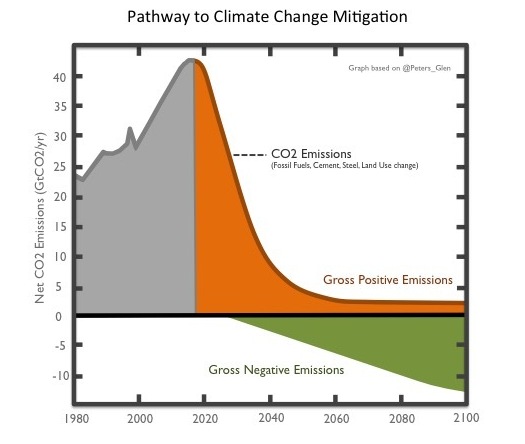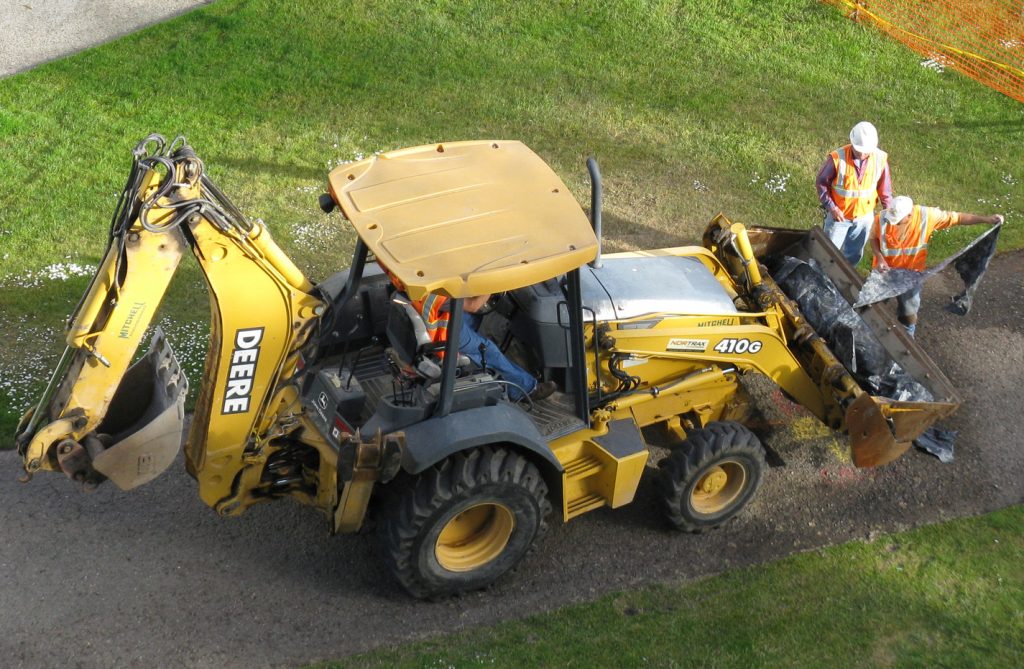
The chart above is of profound importance to landscape architecture as a profession and especially for any practitioner or student under the age of thirty.
This chart, which is based on the science supporting the Paris Climate Agreement, foretells that if we are to have any chance at salvaging a livable climate, humanity must essentially cease the use of fossil fuels within 30 years. Vitally too, this chart shows that we must work to draw down the excess carbon dioxide (CO2) that is already in the atmosphere. These two actions give us the best chance of bringing climate back into a balance conducive to civilization.
This “below zero” era of minimal carbon dioxide emissions and increasing CO2 drawdown will have enormous implications for landscape architects. For while the need for our work will only grow, eliminating the use of fossil fuels would radically alter the materials and construction methods we take for granted. This in turn would have dramatic implications for design and professional practice.
Fossil fuels provide 80% of the energy our society uses (see chart below). 
Their elimination will immediately mean that society will have drastically less energy overall to use. At this point, many people will simply say, “yeah, but we’ll just use renewables.” Unfortunately, renewables are not a significant substitute for fossil fuels: they are not “plug and play.”
Renewables, which currently provide approximately 10% of our total energy supply, are at the mercy of the weather and the revolving earth. Even more importantly, renewables only provide electricity. But it is fossil fueled fire that powers our industrial civilization. It is fire that moves our large machinery and transports our supplies. It is fire that provides us with our most commonly used materials.
And yet this chart tells us that we must end the use of fire if we are to stop and reverse global warming. It is unknown, but seems unlikely, that renewably generated electricity alone can provide us with all the energy and materials that we have grown accustomed to.
For example, cement production is the third largest source of carbon dioxide pollution globally. It is literally impossible to make cement without emitting a large amount of CO2, as that gas is one of the byproducts of the production. Further, fossil fuels alone provide the heat required to expel that CO2. Thus, at the end of the process, as much as one ton of CO2 results from creating one ton of cement.
This is unacceptable in the below zero era. Remember, we can’t keep cheating; we must get to below net zero carbon dioxide emissions. Thus it is unlikely that landscape architects will be able to rely on using large amounts of concrete in their work.
Another example is steel production. Like the cement process, CO2 is a chemical by-product of the process of steel creation. To drive out that CO2 requires very high temperatures, normally supplied by fossil fuels, especially coke, which is a high carbon form of coal. While some quantities of steel can be made with electricity, there is no evidence that large-scale amounts of non-CO2 steel can be produced. Again therefore, large-scale use of steel may be unlikely.
In addition to cement and steel, other common materials that may be severely curtailed by ending the use of fossil fuels include most plastics and metals, fired bricks, ceramics, and glass. But it is doubtful that the need for the functions provided by those materials will decrease correspondingly.

Most construction equipment requires fossil fuels.
Construction methods will also be directly affected. Most landscape architectural projects involve fossil fueled machinery. Trucks, backhoes, skid steers, and earthmovers: all depend on fire. While it is possible to run some equipment on electricity, it is doubtful that we could count on the amount of energy and machinery we utilize today. Therefore, landscape architecture in the below zero era will have to look to other means to perform much of our necessary work.
These realities will deeply influence design. The design process, which now takes insufficient notice of embodied and required carbon in both materials and construction methods, will need to respond to a completely new paradigm. In the future, a principal way that design will be evaluated is by how much carbon it draws down. Designers will learn to work with different materials, including reused and repurposed ones, and find new ways of accomplishing the construction process. Design for maintenance without dependence on fossil fuels will be essential.
The below zero era will also greatly impact professional landscape architecture practice. Managers will need to respond to limits in practice scope compelled by changes in transportation modes. Landscape architects might need to become more directly involved with construction projects. Ethical considerations such as what types of projects to use limited energy on may become more important. Landscape architectural education will need to adjust to these realities as well.
Many will hope that these realities are overstated and that technology and other actions will enable business as usual. They will point to the possibilities of biofuels, carbon scrubbers, massive tree planting to offset emissions, and even geo-engineering as pathways along which we can continue as we have
Unfortunately, there is little evidence that any of those will enable us to continue to pour CO2 into the atmosphere without unimaginable consequences. We have gotten ourselves to a pretty stark place.
The world is on the edge of an epochal change, with two choices for moving forward. We can continue business as usual, accepting the ravages done to our life support system by climate change in the hope that somehow it will be survivable. Or we can voluntarily choose to eliminate fossil fuels and begin to craft a new economy and way of life on different kinds of, and much less, energy. If landscape architects are going to lead with authenticity, it is vital for us to become knowledgeable about the implications and possibilities of the below zero era.
Published in Blog, Cover Story, Featured









![Transforming Tysons [Video]](https://land8.com/wp-content/uploads/2017/12/sp-land8x8-224x150.png)

J. Robert (Bob) Wainner
Steve, while I “agree” with most of what you have stated about the concern for CO2 emissions around the Globe…..IMO, the U.S. should ONLY be responsible for our Nation…….NOT for other Nations around the World. The Paris agreement is totally “unfair” to the United States! Why should U.S. taxpayer pick up the tab for cleaning up the air pollution in China, Pakistan, India, China, etc. Those Nations need to be encouraged to find their OWN solutions. The U.S. has a debt of over $20 Trillion!!!
I watch a lot of K-Drama TV shows on Netflix….many of those programs are filmed in China, Japan & South Korea….In every program you can SEE how terribly filthy their air quality is!!! The air quality in Russia (Moscow) is exceptional bad too….you can barely see to drive on the highways.
Maybe the U.S. should give some of those Nations some “incentives” to clean up their air and STOP all of the excessive CO2 issues,,,,,by cutting some of the Millions of dollars of “Foreign Aid” we send to those Nations every year.
However, with regards to the CO2 problems here in the U.S…..those who advocate that we convert all or most of our gasoline powered vehicles to electrical cars won’t work. Having so many “electrical” powered vehicles in the U.S. would over-load our Nation’s Electrical Power Grid….also, making that Grid susceptible to attack by foreign Nations. Besides, Chevy tried producing hundreds of “electric cars”….they were flawed, problems with batteries, too expensive and people weren’t buying them.
Nicely written article though…….I wish you luck with all that.
Respectfully,
J. Robert (Bob) Wainner
steve austin
thanks for reading and your comment, Bob
steve
Mike
Hi Steve,
This is a useful article in which you have opened my eyes to how much influence the LA design has on increasing the C02 burden, which is a big step away from the green and fluffy landscapes we think are responsible for creating. Importantly, as designers we are reminded that each of us is at the best stage in the design process to seek out ‘greener’ alternatives and challenge design and specifications.
Mike
CMLI.
steve austin
thanks for your comment Mike – yes, we landscape architects can’t pretend to be “green.” We must be committed to working with reality.
steve
J. Robert (Bob) Wainner
Mike, while I understand and admire your enthusiasm………IMO, common sense tells me even IF the U.S. became ZERO free of CO2 emissions……we would still have a ton of it to deal with. Because, as I mentioned, unless American can build a “glass dome” over it to keep CO2 emissions out…..it will continue to be carried into the U.S. via the jet streams from other Nations…..who are much, much worse at NOT controlling their own CO2 emissions.
The U.S. taxpayers should not be responsible for paying to clean up the polluted air in foreign nations. We have a $20 Trillion debt as it is. Those Nations need to deal with their own “environmental” problems….the U.S. can’t force those Nations to do anything they don’t wish to do. Besides, even IF we did give every foreign Nation Billions of dollars to help them improve their CO2 and other environmental issues…..I’m not convinced that’s WHERE the money would actually go.
LAs can only do just so much to help our Nation’s environmental issues. City, State & Federal leaders have more power than we do. As I have practiced for the past 40 yrs…..I have seen our profession disrespected and unappreciated……even by other design disciplines. ASLA may argue with me, but, I really don’t think it is our main objective as Landscape Architects to “Save The Planet”.
And, I find it very interesting that certain “groups” used to used to use the term “Global Warming”….but, now they are using the term “Climate Change” instead. That climate change is a direct cause of CO2. But, we all know……the Earth’s climate has been change for Billions of years….and will continue to do so, regardless of anything we humans here on Earth do or don’t do.
Yes, there are alternative types of “fuels”…..nuclear, natural gas, electrical, wind driven, solar panels, etc….but, in doing some research on ALL of those types of energy recourses…..there is a downside to all them. Interesting too, to learn that the 1.5 Million cattle on our Planet emit 18% of the greenhouse gases…that’s actually more than ALL of the cars, trucks and other vehicles on this Planet. And, the number of livestock is growing. So, we can blame cars (oil) that emit CO2, to a point….but, I think it’s all more complex than we all realize.
Pingback: Sobering Reports on Climate Change impacting Landscape Architecture | Terrain Integration